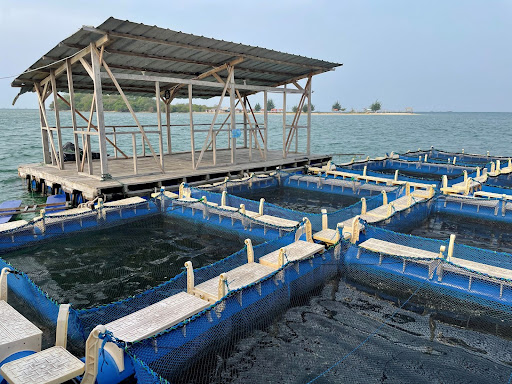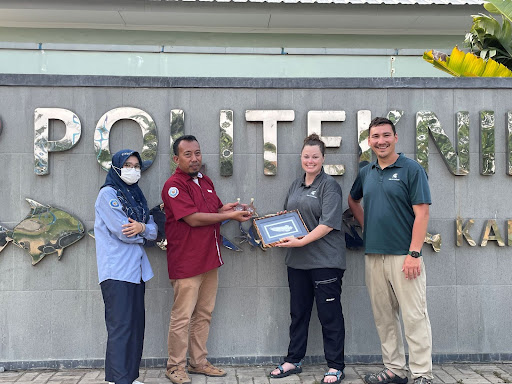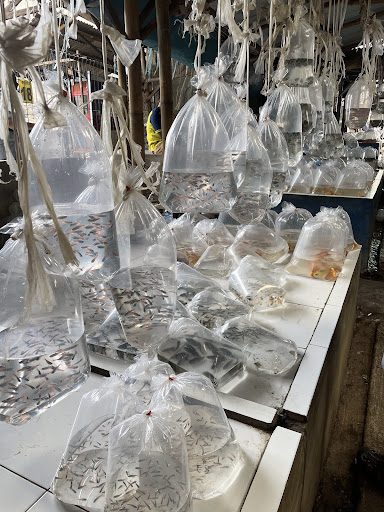Aquaculture literacy and education provides an international perspective
Extension educators enjoy adventure to Indonesian fish farms.

In summer 2022, Michigan State University Extension educators Lauren Jescovitch and Elliot Nelson went on an adventure of a lifetime to Indonesia. Earlier in the spring, Jescovitch was named a 2022 Michigan State University College of Agriculture and Natural Resources (CANR) Global Scholar, an award that provides early- and mid-career MSU employees with seed money to strengthen and expand their global networks and collaborations. The Global Scholar award enabled Jescovitch and Nelson, both Michigan Sea Grant educators, to spend 14 days in Indonesia. Their funded project, “Aquaculture Education: Swimming from Great Lakes to Great Seas,” aims to develop collaborations and key relationships to enhance MSU Extension with global networks in the aquaculture community.

Indonesia is currently the world’s second-largest producer of aquaculture, or farm-raised aquatic products (e.g., fish, shellfish, lobsters, seaweed, etc), with a total production of 15.9 million metric tons, according to the Food and Agriculture Organization (FAO). The United States is the 18th-largest aquaculture producer in the world, with 0.5 million metric tons. Indonesians also consume a lot more nutrient-rich seafood, at a rate of 43.9 pounds per person per year. U.S. residents consume 11.0 pounds per person each year, less than the recommended intake of 26.0 pounds per year.
Unique partnerships possible
Therefore, partnerships in Indonesia could provide optimal case studies of high production aquaculture systems and an aquaculture-literate society accepting of farming in the water. In return, we in the U.S. could provide examples of sustainable practices and seafood consumer safety programs, thus bringing together a very unique partnership.
Jescovitch and Nelson explored many kinds of aquaculture while visiting Indonesia. They were welcomed and hosted by Jakarta Technological University of Fisheries, where Jescovitch presented as a keynote speaker at the National Blue Economy Conference and Trade Exhibition.

After training aquaculture students to use 360-degree cameras and virtual reality technology, Nelson and Jescovitch took their own camera to Bogor and Serang, two cities on the island of Java, where they toured many types of freshwater and saltwater aquaculture farms and research facilities. Then they flew east to Lombok and toured several farms and on-going research projects. Along the way, they captured 360-degree video footage to create virtual tours of the sites.
An abundance of aquaculture
Jescovitch and Nelson saw many different types of systems, species, and end-uses of aquaculture products. The largest end-use was food (or seafood) which included shrimp, lobster, seaweed, algae, pompano, barramundi, grouper, catfish, and more! The next-largest use was ornamental or pet fish, which included breeding of freshwater fishes like knife fish and arowana, and projects that were researching saltwater species like clownfish and blue tangs. Some of the more intricate systems for food products included a mangrove-shrimp pond system that supported ecotourism activities, and a zero waste, sustainable aquaculture system.

Others showcased the difference between net pen systems and cage systems and the variations of their use. Many open-water floating cages held what was known as “the miracle of Lombok,” or lobsters. In these systems, pearl and sand lobsters are cultivated from babies via in-home hatchery systems and grown out in the bay in cages until harvested and packaged for export. Many families and communities clearly depended on these many different seafood supply chains as food security and a way of life.
Webinar describes more
Jescovitch and Nelson recorded snapshots of 360-degree virtual reality content that will be used to enhance their current work with aquaculture education in Michigan. For a glimpse of what 360-degree videos look like, scroll around this short, 25 second clip from their trip touring an ornamental research farm. Want to see and hear more about their experience and their thoughts on the local live fish markets, foods, and culture they experienced? Watch as they share their adventures in this recorded webinar.
Michigan Sea Grant helps to foster economic growth and protect Michigan’s coastal, Great Lakes resources through education, research, and outreach. A collaborative effort of the University of Michigan and Michigan State University and its MSU Extension, Michigan Sea Grant is part of the NOAA-National Sea Grant network of 34 university-based programs.
This article was prepared by Extension educator Lauren N. Jescovitch and Elliot Nelson under award NA18OAR4170102 from the National Oceanic and Atmospheric Administration, U.S. Department of Commerce through the Regents of the University of Michigan. The statements, findings, conclusions, and recommendations are those of the author(s) and do not necessarily reflect the views of the National Oceanic and Atmospheric Administration, the Department of Commerce, or the Regents of the University of Michigan.



 Print
Print Email
Email

